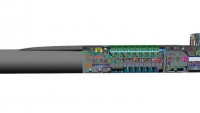40 year-old IBM Minicomputer will help direct any US Nuclear Missile Attack
| Arthur Dominic Villasanta | | May 31, 2016 09:10 AM EDT |
This ... helps control this, a Minuteman-III ICBM with a 300 kiloton nuclear warhead.
The security and reliability offered by legacy computer systems seem to be among the reasons why a 16-bit IBM minicomputer first sold in 1976 is still being used by the U.S. Air Force to "coordinate the operational functions of the United States' nuclear forces, such as intercontinental ballistic missiles, nuclear bombers, and tanker support aircrafts."
Like Us on Facebook
A 16-bit IBM Series-1 minicomputer using 8-bit character encoding might play a key role in launching the United States' Minuteman-III nuclear-armed intercontinental ballistic missiles (ICBMs) against either China or Russia should it come to this. This model is one of the great grandfathers of today's 64-bit desktop PCs.
The Air Force operates some 450 Minuteman-III missiles in blast-proof silos located at secure air bases in Montana, North Dakota and Wyoming. A Minuteman-III can deliver its 300 kiloton W-87 thermonuclear warhead to a target 13,000 kilometers away.
The distance from Wyoming to Moscow is some 8,500 km. The distance to Beijing is 9,700 km.
But there seems to be a method behind this madness of using a 16-bit computer that stores data on 8-inch floppy disks. One source claims legacy systems being low-tech is safer and probably more "hack proof" that current digital systems. There's also the reliability issue.
This Series-1 seems to have been doing a great job for close to half a century so why fix something that isn't broken?
"This system remains in use because, in short, it still works," said Pentagon spokeswoman Lt. Col. Valerie Henderson.
And change always comes hard to the military. But the U.S. Government Accountability Office is bent on forcing the Air Force to ditch this legacy IBM in favor of newer machines.
The Pentagon has announced its replacing the 8-inch floppy drives on the Series-1 with Secure Digital devices by the end of 2017. It plans to fully replace the IBM system by the end of 2020.
TagsIBM Series-1 minicomputer, intercontinental ballistic missiles, U.S. Air Force, 8-inch floppy disks
©2015 Chinatopix All rights reserved. Do not reproduce without permission
EDITOR'S PICKS
-

Did the Trump administration just announce plans for a trade war with ‘hostile’ China and Russia?
-

US Senate passes Taiwan travel bill slammed by China
-

As Yan Sihong’s family grieves, here are other Chinese students who went missing abroad. Some have never been found
-

Beijing blasts Western critics who ‘smear China’ with the term sharp power
-

China Envoy Seeks to Defuse Tensions With U.S. as a Trade War Brews
-

Singapore's Deputy PM Provides Bitcoin Vote of Confidence Amid China's Blanket Bans
-

China warns investors over risks in overseas virtual currency trading
-

Chinese government most trustworthy: survey
-

Kashima Antlers On Course For Back-To-Back Titles
MOST POPULAR
LATEST NEWS
Zhou Yongkang: China's Former Security Chief Sentenced to Life in Prison

China's former Chief of the Ministry of Public Security, Zhou Yongkang, has been given a life sentence after he was found guilty of abusing his office, bribery and deliberately ... Full Article
TRENDING STORY

China Pork Prices Expected to Stabilize As The Supplies Recover

Elephone P9000 Smartphone is now on Sale on Amazon India

There's a Big Chance Cliffhangers Won't Still Be Resolved When Grey's Anatomy Season 13 Returns

Supreme Court Ruled on Samsung vs Apple Dispute for Patent Infringement

Microsoft Surface Pro 5 Rumors and Release Date: What is the Latest?













